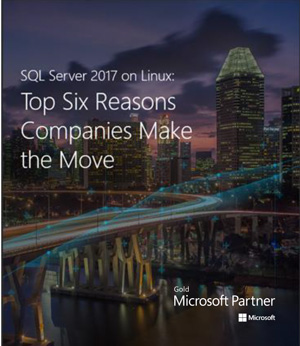Take a ride with Oracle’s self-driving cloud-based data warehouse.
Data is one of your most valuable assets. But today, the scale and speed of incoming data can overwhelm traditional enterprise data warehouses and...

Today’s businesses have widely available unstructured data, and they want to deliver powerful insights through big data. But they must adapt quickly to change by using new technologies that fuel competitive advantage, or risk getting left behind.
That’s why it’s imperative to make the most of big data, the cloud, and intelligence capabilities, all of which help companies accelerate their speed of business through smarter decision-making and faster execution. And that’s the idea behind Microsoft SQL Server 2017.
The complete modern data estate can utilize both structured data—such as OLTP, mobile, ERP, and LOB data—and unstructured data—like graph data, social media, and IoT data.
You need to be able to handle both operational and data warehouse data, and process big data. And you need insights both to look back retrospectively (business intelligence) and to make predictions about the future using machine learning algorithms (advanced analytics with predictive and prescriptive analysis). You also need the flexibility of using the platform, development language, and location of your choice, in both the private and public cloud.
SQL Server 2017 powers your entire data estate by supporting structured and unstructured data sources. It builds on previous versions of SQL Server, which have been industry-leading for four years in a row – as well leading in TPC-E. It scales to petabytes of data and allows you to process big data through PolyBase using T-SQL over any data. SQL Server has also been the least vulnerable database during the last seven years. SQL Server 2017 brings data insights with business intelligence capabilities that provide analytics at a fraction of the cost on any device—along with advanced analytics with support for R and Python.
With SQL Server 2017, application developers can build their applications using any language, including Node.JS, .NET, Java, and PHP, and deploy their solutions on platforms such as Windows, Linux, and Docker containers—all in a private cloud (on-premises), Microsoft Azure, third-party clouds, or a hybrid environment.
Flexibility
Any language, any platform, any cloud. Interoperability you can rely on.
Performance
Quicker queries mean time and money saved. Analytics and transaction processing, simultaneously.
Security
Secure at rest and in motion. Protection that’s centrally managed.
Cost
Don’t pay for more than you have to. Get your investment back faster.
Simplicity
Ease of migration saves time and money.
Everything Built In
An unmatched TCO, with all the features you need.
In the coming months, we’ll post further details on the advantages of moving to SQL Server 2017. In the meantime, a Zones account executive can connect you with our team of Microsoft experts to answer any of your questions. Contact him or her, or call 800.408.ZONES for more information.
You can also download the eBook: SQL Server 2017 on Linux: Top Six Reasons Companies Make the Move now.

Data is one of your most valuable assets. But today, the scale and speed of incoming data can overwhelm traditional enterprise data warehouses and...

Digital transformation is a common trend that’s taking place across the business world right now. Companies worldwide are broadening their digital...
1 min read
Windows 10 is indisputably Microsoft’s best operating system to date. It’s a refreshing mix of the best things from Windows 8 plus returning to the...